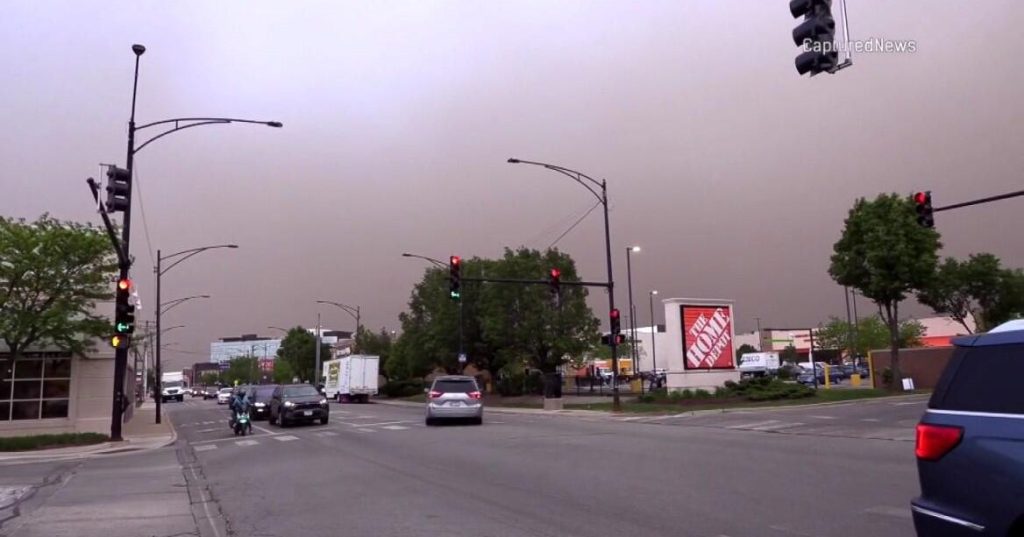A rare dust storm swept through Chicago recently, capturing the attention of residents as it obscured buildings and caused disruptions throughout the city. The phenomenon, characterized by winds reaching 60 to 70 mph, stirred up dust from surrounding farmlands and created a dramatic, swirling haze over the skyline. The National Weather Service acknowledged this event as a significant occurrence, marking only the second issuing of a dust storm warning in Chicago’s history.
| Article Subheadings |
|---|
| 1) Nature’s Fury: Understanding the Dust Storm |
| 2) Local Experiences: Witnessing the Storm |
| 3) Disruptions in Transportation: Impact on Chicago Infrastructure |
| 4) Meteorological Oddities: Rare Weather Events in Urban Areas |
| 5) The Aftermath: Recovery and Clearing of the Skies |
Nature’s Fury: Understanding the Dust Storm
The recent dust storm that engulfed Chicago was primarily caused by exceptionally strong winds, clocked at 60 to 70 mph. These winds kicked up dust from arid farmlands in the surrounding regions, turning what would typically be a clear day into a scene resembling an apocalyptic climate scenario. The National Weather Service reported that this unusual weather phenomenon did not arise from typical thunderstorms, as initially thought, but rather resulted from dry soil conditions exacerbated by high winds. When the storm approached, experts urged people to stay indoors due to the unhealthy levels of particulate matter in the air.
Local Experiences: Witnessing the Storm
Residents who encountered the dust storm described it as an extraordinary and unsettling experience. Individuals like Thomas Jean-Mastej noted how quickly the skies darkened and visibility dropped.
“You can feel the dirt in your eyes, and everything like that,”
Tom Nichin shared, echoing the thoughts of many. People were advised to wear protective eyewear to avoid irritation from airborne dirt. As the storm rolled in, firsthand accounts emerged of people hastily recording the spectacle with their mobile devices, showcasing a mix of awe and concern for their safety. The images captured during this dust storm conveyed an extraordinary image of the Chicago skyline partially veiled by dust.
Disruptions in Transportation: Impact on Chicago Infrastructure
The dust storm’s impact reverberated through Chicago’s transportation infrastructure. Midway International Airport, one of the city’s major airports, experienced substantial delays as a ground stop was enacted to manage incoming flights. Drivers along Interstate 55 faced critical visibility issues, leading many to pull over as dust storm alerts flooded their mobile devices. The scene was chaotic, with highways becoming increasingly congested as travelers attempted to navigate through an uncharacteristically severe weather event. Authorities advised everyone to remain cautious while driving, emphasizing the risks posed by the sudden drop in visibility.
Meteorological Oddities: Rare Weather Events in Urban Areas
Dust storms are more frequently associated with rural regions in Illinois, making their appearance in urban settings like Chicago particularly rare. The National Weather Service noted that this marked only the second time a dust storm warning had been issued for the city, highlighting the unusual nature of the event. Experts explained that urban environments, often characterized by their paved surfaces and dense buildings, are not typically conducive to dust storms. Thus, the occurrence of such an event prompted discussions surrounding climate change and its potential impact on weather patterns in urban landscapes.
The Aftermath: Recovery and Clearing of the Skies
Fortunately, the dust storm’s intensity waned shortly after it impacted the area, with skies beginning to clear within 30 to 45 minutes. However, the experience highlighted a range of emotional responses from residents, reflecting on the surreal nature of the storm. As skies brightened again, residents were left to assess the aftermath, which included both the physical and psychological impact of having experienced such a rare weather event. The unusual storm served as a reminder of nature’s unpredictability and the importance of community preparedness in the face of unexpected environmental challenges.
| No. | Key Points |
|---|---|
| 1 | Chicago experienced a rare dust storm due to strong winds from dry farmlands. |
| 2 | Visibility dropped significantly, prompting safety alerts and emergency responses. |
| 3 | Transportation disruptions occurred, particularly at Midway International Airport. |
| 4 | The dust storm was only the second warning issued for Chicago by the National Weather Service. |
| 5 | The event raised discussions about climate change and weather patterns in urban settings. |
Summary
The recent dust storm serves as a significant reminder of the unpredictability of weather and its potential impacts on urban areas like Chicago. As officials and residents work to understand the effects of climate and prepare for future events, the collective experience around this phenomenon highlights the broader discussions around environmental change. The quick recovery and return to normalcy following the storm, however, demonstrated the resilience of the city and its residents in the face of nature’s fury.
Frequently Asked Questions
Question: What caused the dust storm in Chicago?
The dust storm was a result of powerful winds, reaching speeds of 60 to 70 mph, which blew over dry farmland, stirring up dust and debris into the air.
Question: How did residents react to the dust storm?
Many residents expressed a mix of awe and concern as they rushed to record the event. They reported significant visibility issues and took precautions such as wearing protective eyewear to shield against airborne dirt.
Question: What were the disruptions in transportation caused by the dust storm?
The storm caused a ground stop at Midway International Airport and resulted in significant traffic slowdowns on local highways as drivers faced hazardous visibility conditions.


